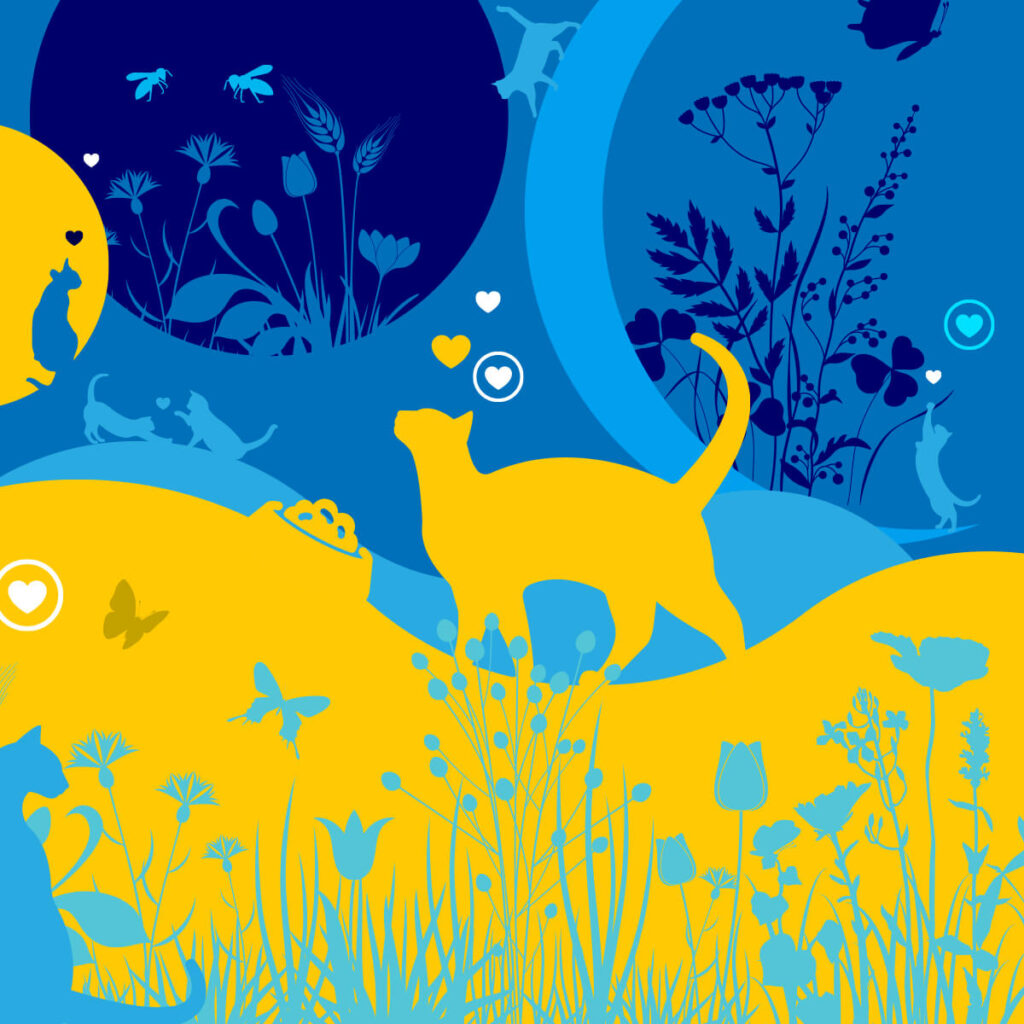How seasonal, hormonal and lunar cycles affect cats
Cats are creatures of habit, but they’re also deeply connected to the natural world. While most of us notice small quirks in our cat’s appetite or routine, few realize how much these patterns are shaped by external forces — from the change of seasons to the phase of the moon. As a science driven company, we want to share the science behind seasonal, hormonal, and lunar influences on feline feeding behaviour, helping you better understand your cat’s appetite through the year.
Seasonal shifts: appetite and the changing year
Studies show that cats, like many mammals, adjust their food intake based on seasonal patterns. Domestic cats tend to eat more in autumn and winter and less in spring and summer. The main driver behind this change appears to be temperature and energy regulation. In colder months, cats require more calories to maintain body heat. As temperatures rise, their energy requirements drop, and so does their appetite.
In addition to temperature, daylight hours (known as the photoperiod) also play a significant role. Longer daylight in spring and summer may reduce melatonin levels, influencing circadian rhythms and potentially appetite. Cats often become more active in warmer seasons, which may also shift their feeding times and patterns.
Hormonal changes: the heat of spring
Hormonal fluctuations, especially in unneutered cats, are particularly noticeable in spring. This is when many cats go into heat, triggered by increasing daylight. During this period, female cats may show restlessness, vocalization, and a noticeable drop in appetite. Male cats may roam more, show increased aggression, or lose interest in food as their focus shifts to mating behaviours.
Even neutered cats, while less affected, can still show mild behavioural changes in spring, likely due to residual hormonal sensitivity and seasonal instincts. Pet owners may notice altered sleeping and activity patterns, which in turn impact eating habits.
Photoperiod and circadian rhythms
Cats’ internal clocks are highly sensitive to light. The change in daylight duration affects not only hormone production but also circadian rhythm — the internal schedule that regulates sleep, wakefulness, and eating. During months with longer daylight, cats may show more daytime activity and shift their feeding habits accordingly. Conversely, shorter days may encourage earlier evening meals and longer rest periods.
Cats kept indoors with artificial lighting might experience these effects less intensely, but subtle behavioural shifts are often still observable.
![]()
Circadian rhythm – this is the internal 24-hour clock that every animal has, including cats and humans. It regulates daily cycles such as activity, sleep, feeding, and hormone levels, and is mainly influenced by light and dark.
Appetite in hot and cold weather
Apart from daylight, ambient temperature has a measurable effect on feline appetite. In hotter weather, digestion can generate additional body heat, which cats instinctively try to avoid. As a result, they may eat smaller meals, graze rather than gorge, or show disinterest in food during the hottest parts of the day.
In colder conditions, the need to maintain core temperature encourages a higher food intake. This is especially evident in outdoor or partially outdoor cats. Offering calorie-dense meals during colder months can help support their increased metabolic needs.
Lunar cycles: subtle influence of the moon
The moon’s impact on animal behaviour has been widely documented in nature, and domestic cats are no exception. Although research in this area is still emerging, some studies and anecdotal reports suggest that cats exhibit changes in behaviour — including feeding — during different phases of the moon.
Full moons are associated with increased activity, particularly at night. The added brightness may disturb sleeping patterns or trigger heightened alertness, potentially shifting feeding times to earlier or later than usual. Some cats may eat more at night or become more vocal and restless, which can either increase or suppress appetite depending on the individual.
Emergency veterinary clinics have reported increased visits during full moons, suggesting that behavioural shifts may lead to higher activity levels or accidents. While not directly tied to eating, this heightened arousal is part of a broader shift in routine that may include feeding behaviour.
Appetite of neutered and unneutered cats
One of the most consistent factors influencing appetite is whether a cat is neutered. Neutered cats typically have fewer fluctuations in hormone levels, making them less sensitive to seasonal triggers. Their eating patterns remain more consistent throughout the year, although they may still respond to changes in temperature and light.
Unneutered cats, on the other hand, show more dramatic changes — especially in spring and early summer. Their natural reproductive cycles are tightly linked to environmental cues, which means their appetite and behaviour are more likely to shift as a result.
Daily changes and preference for variety
In addition to seasonal and environmental factors, cats are also known for their individual preferences and day-to-day changes in appetite. Some cats may love a specific flavour one day and completely ignore it the next. This lack of consistency doesn’t necessarily signal a problem — it’s often just a part of their natural behaviour.
Cats are instinctive grazers and may alternate between eating very little one day and consuming more the next. This behaviour mimics how wild cats eat, depending on the success of their hunting. As long as your cat maintains a healthy weight and shows no signs of illness, these daily shifts in interest or quantity are usually nothing to worry about.
Rotating high-quality flavours and textures can help prevent mealtime boredom and support balanced nutrition. Just be mindful when introducing new foods — gradual transitions are best to avoid digestive upset.
Practical tips for cat owners
Understanding these natural influences can help you better manage your cat’s diet and well-being across the seasons:
- Monitor food intake across the year and adjust portion sizes if needed.
- Expect changes in spring — especially if your cat is unneutered.
- Offer smaller, more frequent meals during hot weather.
- Provide warm, energy-rich meals in winter.
- Keep a regular feeding routine, even if behaviour becomes erratic.
- Track feeding behaviour around full moons if your cat is especially sensitive.
- Don’t panic over day-to-day changes in appetite — it’s often normal.
- Offer variety in flavours and textures to match your cat’s natural curiosity.
Nature still controls cats
Cats may be domesticated, but they remain closely attuned to the natural world. Seasonal changes, hormonal rhythms, light exposure, temperature, and even the moon all influence their behaviour and appetite in subtle but meaningful ways. By paying attention to these patterns and staying flexible with food choices, you can provide more responsive care and build a stronger, more intuitive bond with your feline companion throughout the year.
![]()
Did You Know? Some owners have noticed changes in their cat’s litter box behaviour around the time of a full moon. Increased nighttime activity or restlessness may lead to more frequent urination or shifts in timing. While there’s limited formal research on this specific topic, it may be part of the broader pattern of lunar influence on feline behaviour. If you notice your cat acting differently around the full moon — from eating to sleeping to toileting — you’re not alone.

